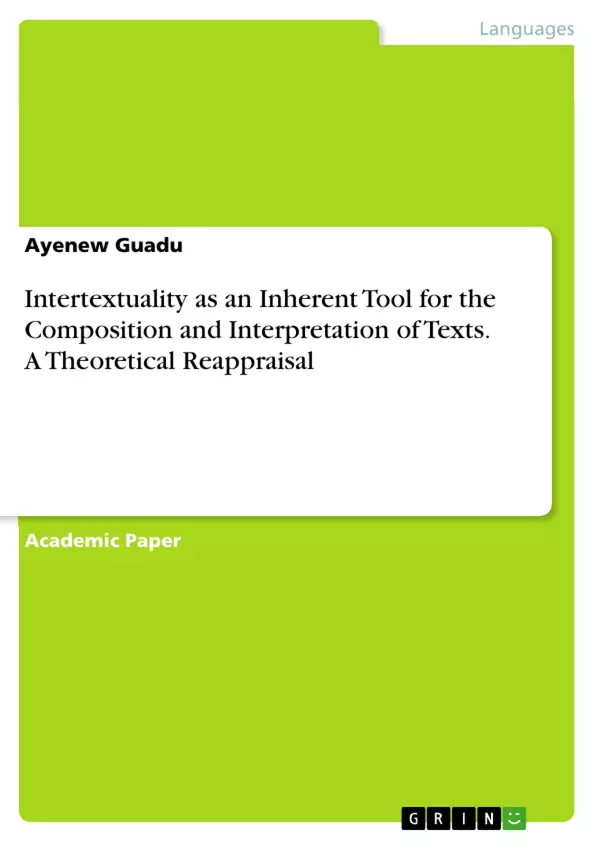The aim of this paper is to discuss the operational concepts and theory of intertextuality as a postmodern theory. Postmodern theory is a theory that emerged in the second half of the 1960s. This theory was born as a reaction to modernity and its ideals. By the 1970s, postmodern aesthetics, on which postmodern theory was based, began to be felt in almost every field of art, from architecture to painting, from literature to cinema. Intertextuality seems such a useful term because it foregrounds notions of relationality, interconnectedness, and interdependence in modern cultural life. In the Postmodern epoch, theorists often claim, it is not possible any longer to speak of originality or the uniqueness of the artistic object, be it a painting or novel, since every artistic object is so clearly assembled from bits and pieces of already existent art. An author or poet can use intertextuality deliberately for a variety of reasons. They would probably choose different ways of highlighting intertextuality depending on their intention. They may use references directly or indirectly. They might use a reference to create additional layers of meaning or make a point or place their work within a particular framework. A writer could also use a reference to create humour, highlight an inspiration or even create a reinterpretation of an existing work. The reasons and ways to use intertextuality are so varied that it is worth looking at each example to establish why and how the method was used
Postmodern theory is an approach that is the sum of certain breaking moments occurring in the historical development of the western societies.
Intertextuality is one of the most important elements among postmodern elements of literature. Postmodernism is a decentered concept of the universe in which individual works are not isolated creations. It means that much of the focus in the study of postmodern literature is settled down on intertextuality. Intertextuality has been the relationship between one text and another or one text within the interwoven fabric of literary history. An indication of postmodernism’s lack of originality and reliance on cliches are pointed out by the famous critics. It is a reference or parallel to another literary work and an extended discussion of a work or the adoption of a style.
Table of Contents
- I. Introduction
- 1. Operational Definition of Intertextuality...
- 2. Theories of Intertextuality...
- 2.1. Bakhtin's Theory of Intertextuality..
- 2.2. Kristeva's Theory of Intertextuality
- 2.3. Barthes's Theory of Intertextuality..
- 2.4. Genette's Theory of Intertextuality.
- 3. Two General Forms of Intertextuality in Literature...
- 4. Intertextual Practice in the Postmodern Age
- II. Conclusion
Objectives and Key Themes
This paper aims to explore the concept of intertextuality within the framework of postmodern theory. It delves into the operational definition of intertextuality and examines various theories of intertextuality proposed by prominent literary critics and theorists, such as Bakhtin, Kristeva, Barthes, and Genette. The paper also explores how intertextuality is manifested in postmodern literature.
- Intertextuality as a defining characteristic of postmodern literature
- Theories of intertextuality by Bakhtin, Kristeva, Barthes, and Genette
- The role of intertextuality in the generation of meaning and understanding
- The various forms and manifestations of intertextuality in literary texts
- The implications of intertextuality for the study of literature and culture
Chapter Summaries
- I. Introduction
- This chapter defines intertextuality as a core concept of postmodern theory and its significance in contemporary literary discourse.
- It presents a brief overview of the origins and characteristics of postmodernism, highlighting its rejection of traditional notions of originality and its emphasis on the interconnectedness of texts.
- The chapter introduces the key figures who have contributed to the development of intertextuality theory, including Julia Kristeva, Mikhail Bakhtin, Roland Barthes, and Gérard Genette.
- 1. Operational Definition of Intertextuality
- This chapter provides a comprehensive operational definition of intertextuality, drawing upon the work of prominent literary theorists such as Abbott, Abrams, Bennet and Royle, and Childs and Fowler.
- It explores the various ways in which intertextuality manifests itself in literary works, ranging from explicit citations and allusions to more subtle forms of influence and adaptation.
- The chapter emphasizes that intertextuality is a fundamental aspect of the literary tradition, demonstrating how texts are constantly in dialogue with one another, shaping and influencing each other's meaning.
- 2. Theories of Intertextuality
- This chapter examines the key theoretical frameworks of intertextuality developed by Bakhtin, Kristeva, Barthes, and Genette.
- It analyzes each theorist's distinct approach to intertextuality, highlighting their respective contributions to the understanding of this complex literary concept.
- The chapter explores the connections and differences between these theories, providing a nuanced perspective on the evolution of intertextuality theory.
- 3. Two General Forms of Intertextuality in Literature
- This chapter examines two general forms of intertextuality in literature: allusion and pastiche.
- It explores how each form of intertextuality contributes to the meaning and impact of literary works.
- The chapter provides examples of how these forms of intertextuality are used in specific works, illustrating their significance in literary analysis.
- 4. Intertextual Practice in the Postmodern Age
- This chapter examines the prominent role of intertextuality in postmodern literature.
- It explores how postmodern authors use intertextuality to challenge traditional notions of authorship, originality, and meaning.
- The chapter examines examples of postmodern works that demonstrate the use of intertextuality, showcasing its distinctive features in this literary movement.
Keywords
The primary keywords and focal points of this paper are: intertextuality, postmodern theory, literary genres, literary criticism, text theory, postmodern literature, dialogism, polyphony, allusion, pastiche, citation, adaptation, transformation, literary tradition, and cultural context.
- Quote paper
- Ayenew Guadu (Author), 2023, Intertextuality as an Inherent Tool for the Composition and Interpretation of Texts. A Theoretical Reappraisal, Munich, GRIN Verlag, https://www.grin.com/document/1349464



